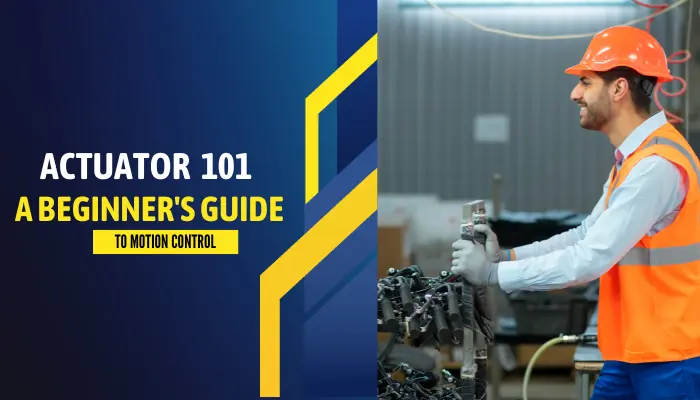Actuators 101: A Beginner's Guide to Motion Control

Are you curious about the world of motion control and how things move? Actuators are at the heart of this fascinating field. In this beginner's guide, we'll dive into the world of actuators, exploring what they are, how they work, and their various applications. By the end of this article, you'll have a solid grasp of actuators and their role in shaping the technology around us.
What Are Actuators?
Actuators are devices responsible for controlling or moving systems, machines, or mechanisms. They play a vital role in converting energy into motion, making them a fundamental component in various industries, including robotics, automotive, aerospace, and manufacturing.
Actuators come in various shapes and sizes, but they all serve the same primary purpose: to initiate or control motion. Whether it's the movement of a robotic arm, the adjustment of a camera lens, or the operation of a car's throttle, actuators are the silent heroes behind these actions.
Let's Know about theTypes of Actuators
Actuators can be categorised into several types based on their principle of operation. Here are some common types of actuators:
Electric Actuators
Electric actuators use electrical energy to generate motion. They are widely used in applications requiring precision and control, such as industrial automation and robotics. Electric actuators can be further divided into subtypes, including linear actuators and rotary actuators.
Hydraulic Actuators
Hydraulic actuators utilise pressurised fluid to produce motion. These actuators are known for their high force output, making them suitable for heavy-duty applications like construction equipment and aircraft landing gear.
Pneumatic Actuators
Pneumatic actuators operate using compressed air to create motion. They are lightweight and cost-effective, commonly used in industries requiring rapid motion, such as in the packaging and food processing sectors.
Piezoelectric Actuators
Piezoelectric actuators rely on the piezoelectric effect, where certain materials deform when an electric field is applied. These actuators are incredibly precise and are often found in nanotechnology and medical devices.
Thermal Actuators
Thermal actuators, as the name suggests, use heat to produce motion. They are used in applications like thermal valves and switches, where precise temperature control is essential.
How Do Actuators Work?
The working principle of an actuator depends on its type. Let's take a closer look at how a few common actuators operate:
Electric Actuators
Electric actuators typically consist of a motor, a gearbox, and a lead screw. When an electrical current is applied to the motor, it generates rotational motion. The gearbox then converts this motion into linear motion using the lead screw. This linear motion is what drives the actuator's intended function.
Hydraulic Actuators
Hydraulic actuators use the pressure of a hydraulic fluid, typically oil, to create motion. When the fluid is pressurised, it pushes against a piston or cylinder, generating linear motion. This motion can be controlled by adjusting the pressure in the system.
Pneumatic Actuators
Pneumatic actuators use compressed air to move a piston or diaphragm. When the air pressure changes, it causes the piston or diaphragm to move, creating motion. Pneumatic actuators are known for their speed and simplicity.
Piezoelectric Actuators
Piezoelectric actuators work on the principle that certain materials expand or contract when subjected to an electric field. When voltage is applied to the piezoelectric material, it deforms, creating motion. These actuators are highly precise and are used in applications requiring fine adjustments.
Thermal Actuators
Thermal actuators rely on the expansion and contraction of materials due to temperature changes. By carefully controlling the temperature, these actuators can produce motion. They are often used in situations where precise temperature control is critical.
Applications of Actuators
Actuators find applications in numerous industries and everyday products. Here are some examples:
Robotics
In robotics, actuators are the muscles that enable robots to move and interact with their environment. From robotic arms on manufacturing lines to the legs of walking robots, actuators are the key to mobility and agility.
Automotive
Actuators play a crucial role in modern automobiles, controlling various functions such as engine performance, braking, and steering. Electric actuators are often used in power windows and door locks, while hydraulic actuators can be found in power steering systems.
Aerospace
Aerospace applications demand precision and reliability, and actuators are instrumental in controlling aircraft components like flaps, landing gear, and engine thrust.
Industrial Automation
In manufacturing and industrial settings, actuators are employed in conveyor systems, robotic welders, and CNC machines, where precise and repeatable motion control is essential.
Consumer Electronics
Even in everyday gadgets like smartphones and cameras, actuators are responsible for functions like autofocus, image stabilisation, and touch-screen sensitivity.
Conclusion
In this beginner's guide to actuators, we've explored what actuators are, the various types available, how they work, and their wide-ranging applications. Actuators are the unsung heroes of motion control, making our lives easier and more efficient by powering countless devices and systems. As you delve into the world of technology and automation, remember that actuators are the driving force behind many of the movements you encounter daily. Whether building a robot, driving a car, or simply using your smartphone, you're interacting with the fascinating world of actuators.